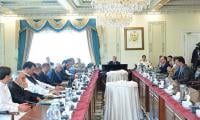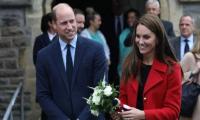This is my John Reed moment. I feel like writing a sequel to ‘Ten days that shook the world’, the famous eyewitness account of the Russian Revolution that happened exactly one hundred years ago. In fact, there is a lot more happening in today’s Pakistan and one can be easily killed through a sensory overload.
Life in Islamabad has been badly disrupted by a dharna led by Maulana Khadim Hussain Rizvi. Rizvi may be an ustaad (teacher), who has spent all of his adult life teaching at madressahs and delivering Friday sermons, yet he appears like a shagird (student) of Imran Khan in political strategy.
He shot to fame through a failed copy-cat dharna staged last year at D-Chowk, just after Mumtaz Qadri was hanged on February 29. The small crowd of his followers was easily besieged by the police and forced to vacate the strategic location after an ‘amicable agreement’. However, the event was immortalised due to viral video clips that showed him uttering sacred text and abusive language in the same breath. Rizvi also informed his participants that the souls of the saints of the highest order were also participating in the dharna. The most famous clips show his followers trying to shoot down a helicopter by throwing shoes at it.
Rizvi and his group of followers are neither small nor funny any longer. His newly formed political party, Tehreek-e-Labbaik ya Rasool Allah, showed an impressive performance in the by-elections in NA-120 Lahore in September this year, vacated due to the disqualification of Nawaz Sharif. The candidate supported by the newly founded political party bagged 5,822 (4.59 percent) votes. It repeated this performance in the by-election for NA 4 Peshawar in October where its candidate bagged 9,935 (7.57 percent) votes. In both constituencies, Tehreek-e-Labbaik left candidates of established religious parties trailing far behind.
Tehreek-e-Labbaik marks the return of Barelvi religious politics to the national mainstream. Barelvi politics had been marginalised since the Jamiat-Ulema-e-Pakistan led by Maulana Shah Ahmad Noorani became irrelevant in the 1980s, mainly due to the popularity of the MQM in urban Sindh. Though Tahirul Qadri did not define his party as such, the Awami Tehreek can be categorised as a Barelvi party. This party became victim to the mercurial temperament of its saintly founder and could not make any headway despite much fanfare.
The element of anger is clear in the politics of Barelvi religious groups, particularly Tehreek-e-Labbaik. These groups represent both the folk forms of Islam and the Barelvi school of thought. Their followers mostly come from lower middle and working class backgrounds, and have not been touched by the PTI’s revolution. These religious groups have been humiliated for more than a century. Revivalist movements that emerged in India in the mid-nineteenth century and even earlier saw traditional religious practices as adulteration to the pure form of Islam, and therefore as dangerous to Muslims. They thought that Muslim states went through a decline only because of such practices.
Pakistan’s educated middle class inherited this bias and chose to adopt a more orthodox form of Islam as the state religion. The worst blow came in 1959, when Ayub’s modernising government took control of shrines and Waqf properties associated with shrines.
During the Zia era, Barelvi groups did not receive any foreign funding and no jihadi groups were raised from amongst them. They were kept out of violence through a state policy, not necessarily through their own inclination or decision. However, lack of muscle cost them dearly as their mosques were overtaken and they could not compete with other sects in religious infrastructure due to lack of patronage and funding.
The recent uprising also marks the end of the romance of a section of the educated middle class with the Barelvi denomination; this group equated this school of thought with Sufi Islam, which is not entirely true. Sufi Islam, folk religion and the Barelvi school of thought are three different traditions that overlap at certain points and have no convergence at many other points.
These new trends have rung an alarm bell not only for the major political parties like the PML-N which had won over these voters over decades, but also for the established religious parties. Both the by-elections (NA-120 and NA-4) have shown that the religious voter is willing to vote again for religious parties. However, rather than returning to the established political parties, the religious voter is inclined to vote for new religio-political entities that are more extremist in their interpretation of religion. Perhaps, it is the fear of getting marginalised that got the major religious parties united once again under the banner of the Muttahida Majlis-e-Amal (MMA).
The newly revived MMA has the option of incorporating the Tehreek-e-Labbaik (and the Milli Muslim League) in the alliance or keeping it out and trying to marginalise it. The MMA may not feel much threat in its safe constituencies in Khyber Pakhtunkhwa and Balochistan where the two major religious parties have a strong patronage network.
In Punjab’s battleground, the MMA’s main power lies in influencing the battle between the PTI and PML-N. It can potentially sway the battle one way or the other through forming a political alliance with one party or fighting it alone and seriously harming the vote bank of one political party or the other in closely contested constituencies.
The MMA is bound to miss Pervez Musharraf who mentored the alliance to keep the two major political parties at bay and also in order to play the ‘after me, mullahs’ card with the US. Musharraf, on his part, has announced a ‘grand alliance’ of 23 political parties that will operate under the umbrella of the Pakistan Awami Ittehad (PAI). Going by the number of constituent parties, it must be the largest political alliance in the country’s history; the Pakistan National Alliance (PNA), the famous alliance that threw out Zulfikar Ali Bhutto’s government through its movement which resulted in Zia’s martial law, comprised only nine parties. Interestingly, most parties forming part of Musharraf’s PAI were lurking in the shadows before Musharraf announced his move.
Musharraf’s grand alliance came only a couple of days after he agreed graciously to lead a new party formed by the merger of the MQM-Pakistan and Pak Sarzameen Party (PSP). The merger, as we know, did not materialise and Musharraf, we know, had not been asked to lead it.
The battle between the MQM-P and the PSP over the legacy of Altaf Hussain’s MQM is not over yet. It is simultaneously a personal and factional struggle. The pack led by Farooq Sattar under the banner of the MQM-Pakistan feel that they should be allowed to carry the legacy of the original party – minus violence, crime and Altaf Hussain.
Mustafa Kamal, once the second best mayor in the world, has the ambition to form a new nationwide party and, like most ambitious men, he is in a hurry. Unfortunately, his ambition does not appear to match his political acumen or political appeal. To stake the claim over Bhai’s throne, he needs to defeat Farooq Sattar, the greatest survivor of a party that has not been kind to its own leaders.
As if all these things weren’t enough, Mumtaz Bhutto decided to merge his Sindh National Front once again, this time with the PTI. The PTI now has some Bhutto blood in its veins and the colourful Mustafa Khar has already joined the party. Half a century after the PPP was founded and a century after the communist revolution took place, these interesting times are turning us into our own caricatures.
The writer is an anthropologist and development professional.
Email: zaighamkhan@yahoo.com
Twitter: @zaighamkhan
People stand in line up as election officials check their ballot papers during voting general election at a polling...
Women show their voter identity cards as they stand in a queue before casting their votes in Agartala. — PTIThe 18th...
Former prime minister Imran Khan. — Instagram/ imrankhan.ptiAn old saying has it that “when you dance with the...
Kashmiris in Indian illegally occupied Kashmir protesting against the Indian occupation as the forces of India looked...
A representational image showing residents walking at a wholesale market in Karachi. — AFP/FileOnce again there is...
A representational image showing late Pakistani human rights activist and Supreme Court lawyer Asma Jahangir. —...







